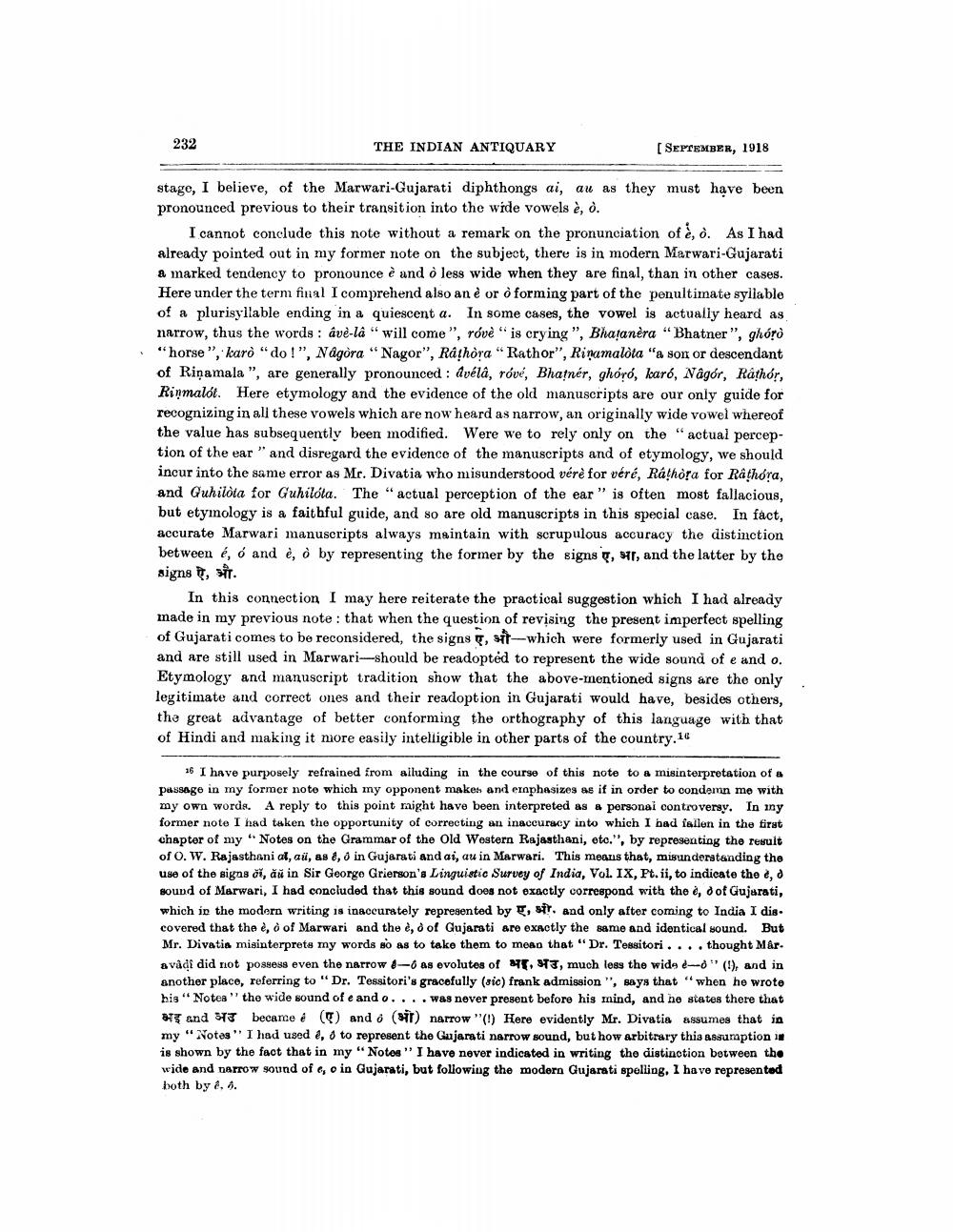________________
232
THE INDIAN ANTIQUARY
[ SEPTEMBER, 1918
stage, I believe, of the Marwari-Gujarati diphthongs ai, au as they must have been pronounced previous to their transition into the wide vowels è, 0.
I cannot conclude this note without a remark on the pronunciation of è, o. As I had already pointed out in my former note on the subject, there is in modern Marwari-Gujarati a marked tendency to pronounce è and ò less wide when they are final, than in other cases. Here under the term final I comprehend also an è or ò forming part of the penultimate syllable of a plurisyllable ending in a quiescent a. In some cases, the vowel is actually heard as narrow, thus the words : avè-là " will come", róve" is crying ", Bhatanera "Bhatner", ghórò "horse", karò "do!", Någora "Nagor", Raphòra "Rathor", Rinamalota "a son or descendant of Riņamala", are generally pronounced : Qvélâ, rové, Bhatnér, ghóró, karó, Nagór, Ráthor, Rinmalót. Here etymology and the evidence of the old manuscripts are our only guide for recognizing in all these vowels which are now heard as narrow, an originally wide vowel whereof the value has subsequently been modified. Were we to rely only on the "actual perception of the ear " and disregard the evidence of the manuscripts and of etymology, we should incur into the same error as Mr. Divatia who misunderstood vérè for véré, Ráthora for Rathora, and Guhilota for Guhilóta. The "actual perception of the ear" is often most fallacious, but etymology is a faithful guide, and so are old manuscripts in this special case. In fact, accurate Marwari manuscripts always maintain with scrupulous accuracy the distinction between é, o and è, ò by representing the former by the signs, wr, and the latter by the signs t, .
In this connection I may here reiterate the practical suggestion which I had already made in my previous note: that when the question of revising the present imperfect spelling of Gujarati comes to be reconsidered, the signs, s-which were formerly used in Gujarati and are still used in Marwari-should be readopted to represent the wide sound of e and o. Etymology and manuscript tradition show that the above-mentioned signs are the only legitimate and correct ones and their readoption in Gujarati would have, besides others, the great advantage of better conforming the orthography of this language with that of Hindi and making it more easily intelligible in other parts of the country.10
16 I have purposely refrained from alluding in the course of this note to a misinterpretation of a passage in my former noto which my opponent makes and emphasizes as if in order to condemn me with my own words. A reply to this point might have been interpreted as a personal controversy. In iny
note I had taken the opportunity of correcting an inaccuracy into which I had fallen in the first chaptor of my "Notes on the Grammar of the Old Western Rajasthani, oto.. by representing the result of O. W. Rajasthani at, ai, as ,0 in Gujarati and ai, au in Marwari. This means that, misunderstanding the use of the signs či, ăü in Sir George Grierson's Linguistic Survey of India, Vol. IX, Pt. ii, to indicate the e, sound of Marwari, I had concluded that this sound does not exactly correspond with the e, o of Gujarati, which in the modern writing 18 inaccurately represented by U, str. and only after coming to India I dis. covered that the è, è of Marwari and the è, o of Gujarati are exactly the same and identical sound. But Mr. Divatia misinterprete my words so as to take them to mean that "Dr. Tessitori .... thought Már. avadi did not possess even the narrow 1-O as evolutes of 6, 93, much less the wide -O" (), and in another place, referring to "Dr. Tessitori's gracefully (sic) frank admission ", says that " when he wroto his" Notea" the wide sound of eando.... was never present before his mind, and he states there that *3 and 575 became & (T) and (1) narrow "(!) Here evidently Mr. Divatia assumes that in my "Notes I had used é, o to represent the Gujarati narrow sound, but how arbitrary this assumption in is shown by the fact that in my "Notes I have never indicated in writing the distinction between the wide and narrow sound of Go in Gujarati, but following the modern Gujarati spelling, I have represented both by 2.9.




